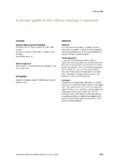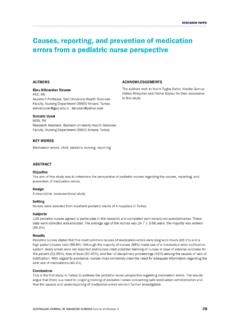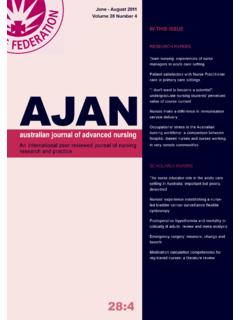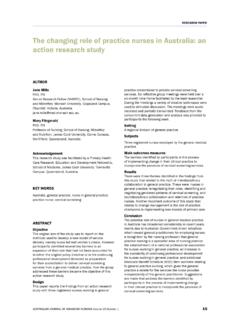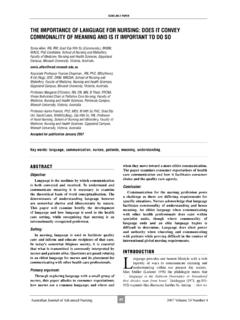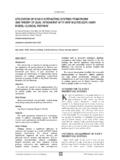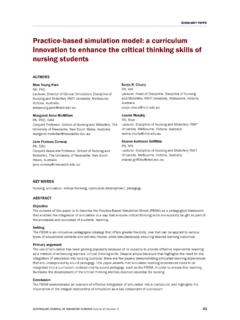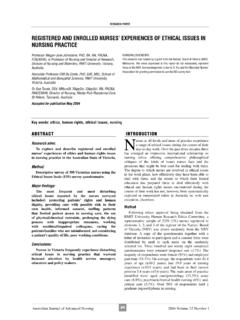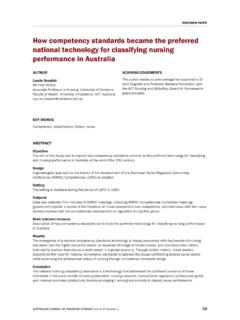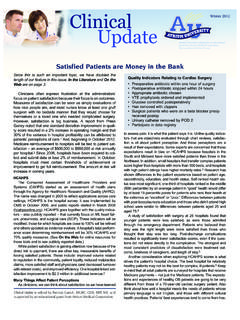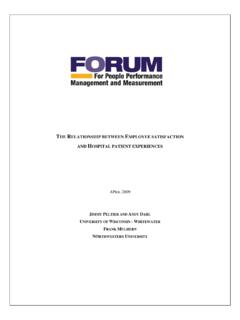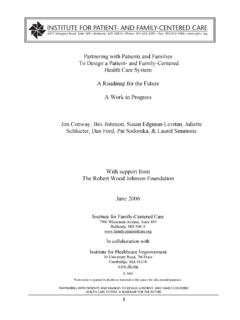Transcription of Patient satisfaction with Nurse Practitioner care in ...
1 AUSTRALIAN JOURNAL OF ADVANCED NURSING Volume 28 Number 412 RESEARCH PAPERP atient satisfaction with Nurse Practitioner care in primary care settingsAUTHORSMary Jo Gagan PhD, PCHNP, FAANP Senior Lecturer, University of Otago Centre for Postgraduate Nursing Studies, Christchurch, New Zealand. MaybeeEdD, PHCNP candidate, FAANP Senior Lecturer, University of Otago Centre for Postgraduate Nursing Studies, Christchurch, New Zealand. WORDSN urse Practitioners, primary care , Patient satisfactionABSTRACTO bjectiveTo determine the level of satisfaction with care and acceptance of the role of Nurse Practitioner in New descriptive correlational study was conducted using a 15 item satisfaction survey distributed to participants by the clinic receptionist after a clinic visit to the NP. Demographic data, reason for visit and waiting times were also collected.
2 SettingTwo clinical sites in the same medium sized city were used for data collection. The first site was a university campus health clinic and the second a primary health care clinic in an industrial area. SubjectsConvenience sample of the first 100 patients to complete and return the self administered survey from each practice site were to be included in the study. In fact 193 useable surveys were measuresPatient satisfaction and acceptance was measured using modified 15 item version of the Thrasher and Purc Stephenson (2008) satisfaction survey. ResultsPatients were satisfied with the care they received and had accepted the role. Mean satisfaction score was ; SD , range 12 25. The lower the score the more satisfied the Patient . satisfaction was significantly correlated by only two variables, age (r=.221, p=.003) and role clarity (r=.)
3 355, p=.000).ConclusionsWhile this study contained limitations, the overall positive findings are similar to previous study findings on Patient satisfaction with Nurse Practitioners care . The instrument, methodology, and findings of this study can be used as initial data on the evaluation and continued monitoring of the role in New Zealand (NZ).AUSTRALIAN JOURNAL OF ADVANCED NURSING Volume 28 Number 413 RESEARCH PAPERINTRODUCTIONNew Zealand like many western countries is currently experiencing a critical health care workforce shortage. Over ten years ago the role of the Nurse Practitioner (NP) was identified and supported by the New Zealand Ministry of Health (Ministerial Taskforce on Nursing 1998) as one approach to relieving this shortage and providing a career ladder to expert clinical nurses. Seven years ago the Nursing Council of New Zealand began to register individuals as Nurse Practitioners (NP).
4 Today there are approximately 70 recognised NPs in New Zealand, a country of over four million people (NPNZ listserve April 2010). To date little research has been published in New Zealand on the outcomes these providers are achieving. However data have been presented at symposiums and conferences addressing NP experiences and outcomes in a variety of settings (Boyd 2009; Gilmer 2009; Langer 2009). This article presents data on Patient satisfaction and acceptance of the NP role in a sample of patients in ReviewNurse Practitioners in outside of NZ have been shown to positively impact the quality and quantity of life experienced by the individuals, families, and communities they serve (Brown and Grimes 1995; Cooper et al 2000; Shumm et al 2000; Cooper et al 2002; Larkin 2003). NPs have also been shown to practice in a cost effective manner (Jenkins and Torrisi 1995; Spitzer 1997; Hunter et al 1999; Paez and Allen 2006; Bauer 2010).
5 In addition NP care has been associated with increased Patient satisfaction over other models of care delivery (Brown and Grimes 1995; Byrne, Richardson, Brunsdon, & Patel (2000)); Brooten et al 2002 . Researchers addressing the implementation and evaluation of the NP role advocate for initial studies to address outcomes related to safety and efficacy, acceptance and satisfaction , costs and role transfer (Mitchell DiCenso et al 1996; Bryant Lukosius, & Dicenso, (2004). Unpublished works in New Zealand by Boyd (2009) speak to the safety, efficacy and financial impact of the NP role in gerontology practice, while Langer s (2009) work addressed safety and role transfer in a mental health setting and Gilmer s (2009) work looked at acceptance of the role in a primary care setting. No data have yet been published on acceptance and satisfaction of the NP role in New stated above, satisfaction is one of the key outcomes associated with the introduction of a new role in health care delivery.)
6 Some researchers have linked satisfaction with outcomes of improved health status (Lashinger et al 2003), decreased use of healthcare resources (Thompson et al 1996), and increased adherence to plans of care (Moore et al 2002).Measuring outcomes requires the use of validated instruments to accurately capture the concepts under study. Measuring satisfaction can be difficult as many factors may influence a Patient s satisfaction with care on any given day. Thrasher and Purc Stephenson (2008) developed and tested an instrument to measure satisfaction with NP care provided in an emergency department in Canada. This instrument, adapted and used in this study, is discussed further in the sections to descriptive study presents initial data on two outcomes of NP practice, satisfaction and acceptance.
7 satisfaction was selected as one variable where quality measures have been developed and tested, satisfaction with care Survey (Thrasher and Purc Stephenson 2008). The satisfaction with care instrument contained 21 items that loaded into three factors labelled attentiveness, comprehensive care and role clarity. Of the 21 original items in this instrument 13 items accounted for of the variance in the measure. These 13 items were included in the current study along with two additional items. One additional item was included to capture the overall satisfaction level of the respondent (item # 11,) and the other additional item was included to address acceptance of the NP role (item#15). Table 1 includes all the items used in the JOURNAL OF ADVANCED NURSING Volume 28 Number 414 RESEARCH PAPERT able 1: Items of the satisfaction SurveySatisfaction 1.
8 The Nurse Practitioner gave me a chance to say what was on my mind. 2. The Nurse Practitioner was friendly to me. 3. I felt free to talk to the Nurse Practitioner about private thoughts. 4. I feel the Nurse Practitioner spent enough time with me. 5. The Nurse Practitioner took my problems very seriously. 6. I would trust the Nurse Practitioner with my health. 7. The Nurse Practitioner provided information about how to look after my health/problem. 8. The Nurse Practitioner took time to answer my questions or address my concerns. 9. The Nurse Practitioner provided excellent care . 10. The Nurse Practitioner was successful in dealing with my problem*11. Over all I was very satisfied with the care I received from the Nurse Practitioner .**15. I am likely to refer a friend or family member to the Nurse PractitionerRole Clarity12.
9 I am clear on how a Nurse Practitioner s role is different from a Nurse s I am clear on how a Nurse Practitioner s role is different from a doctor s I am clear on how a Nurse Practitioner is trained.* Added in this project overall satisfaction ** Included in satisfaction score but also represented acceptance. Two practice sites were used for data collection. The first site was a primary care clinic in a mixed industrial residential area of a medium sized city where one Primary Health care NP worked two days per week. The second site was a university campus health setting where a Primary Health care Nurse Practitioner Intern was employed one day per convenience sample of 200 patients was the goal. The first 100 from each of the two practices to complete and return the questionnaire were included in the study.
10 However upon data entry and cleaning it was determined that seven subjects actually returned blank surveys and several others left some responses blank. Verbal permission was obtained from clinic administrator s in both sites for the study. Approval from both sites was obtained after the research protocol, Patient information sheet, and questionnaire were presented along with assurance to the clinic administrators that appropriate ethics approval would be obtained prior to data collection. Ethical approval was received from the ethics committee affiliated with the researchers employing university. An administrative assistant or clinic receptionist in each site distributed the participant explanation letter and the questionnaires to patients at the completion of their visit with the NP. The assistant asked each Patient to complete and place the completed questionnaire in a sealed box in the waiting room on the Patient s way out of the clinic.
